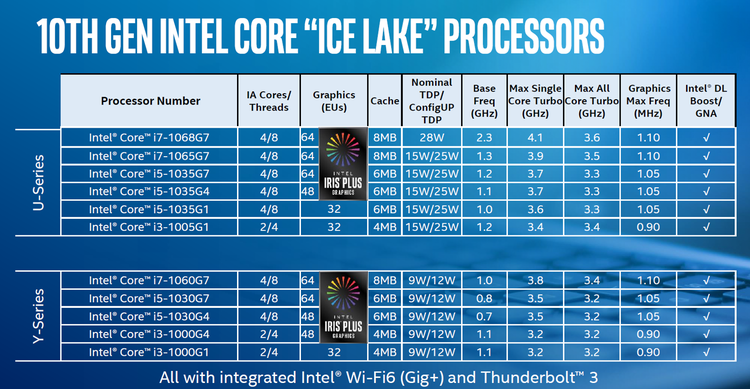Intel Reveals Specs For 11 10th-Gen Core 'Ice Lake' Mobile Processors
'Ice Lake is [Intel's] biggest step forward in systematically thinking about AI,' Intel executive Ran Senderovitz says of the company's upcoming 10th-generation Core processors that will power new ultra-thin laptops coming out later this year.

Intel has revealed the specifications for its 10th-generation Core "Ice Lake" mobile processors that will bring new artificial intelligence and graphics capabilities to ultra-thin laptops later this year.
The "Ice Lake" mobile processors, which are based on the chipmaker's 10-nanometer manufacturing process, consist of 11 SKUs split between the higher-wattage U-Series and lower-wattage Y-Series, ranging from the Core i9 to the Core i3, which the company disclosed on Thursday.
[Related: How Intel Aims To Push Laptop Innovation Again With Project Athena]
Ran Senderovitz, vice president of mobile platform marketing at Intel, said the company will disclose more 10th-generation Core processors in every PC segment in the next 12 months, including new mobile PC products for multi-threaded, high productivity and commercial segments, which will be revealed at the end of August.
"The 10th-generation family will be based on architecture that best fits each one of the workloads," he said, adding that the "Ice Lake" processors will be in more than 35 laptop designs by the holiday season.
The "Ice Lake" U-Series is headlined by the Intel Core i7 1068G7, which comes with four cores, eight threads, a 2.3-gigahertz base frequency, a 4.1-gigahertz max turbo frequency on one core and a 3.6-gigahertz max turbo frequency on all cores. The processor has the highest thermal design power out of the U-Series at 28 watts while the rest sit between 15 and 25 watts.
The Y-Series equivalent is the Intel Core i7-1060G7, which also comes with four cores, eight threads and an 8-megabyte cache but lower clock speeds: a 1-gigahertz base frequency, a 3.8-gigahertz max turbo frequency for one core and a 3.4-gigahertz max turbo frequency for all cores. This processor's nominal thermal design power is 9 watts and can be figured up to 12 watts, like the rest of the Y-Series.
The two headlining processors both comes with Intel Iris Plus Graphics, which Senderovitz said will provide the best integrated graphics performance in the industry.
"Now you'll be able to play top games in form factors not possible before," he said.
Iris Plus Graphics, the company's 11th-generation integrated graphics, features 64 execution units and a 1.1-gigahertz max graphics. The lowest-end processors of the U-Series and Y-Series, the Intel Core i3-1000G1, Intel Core i5-1035G1 and Intel Core i3-1005G1, do not come with Iris Plus Graphics.
As previously disclosed, the "Ice Lake" mobile processors will come with a set of new AI capabilities, including Intel's Deep Learning Boost processor instructions that can be used for low-latency, burst workloads. The integrated graphics also come with AI capabilities, supporting high throughput and sustained workloads. Lastly, the processors come with a low-power accelerator for voice applications.
"'Ice Lake' is [Intel's] biggest step forward in systematically thinking about AI," Senderovitz said.
Dell's next-generation XPS 13 2-in-1 will be among the first ultra-thin laptops to launch with Intel's 10th-generation Core mobile processors this year. The upcoming HP Envy 2-in-1s, which will be built with actual wood, will also come with the "Ice Lake" processors.